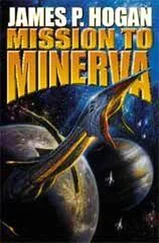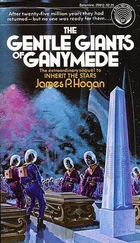Earth’s physicists were having to do a lot of rethinking to accommodate the new facts brought by the Ganymeans. Some of the most far-reaching revelations had to do with the fundamental nature of matter itself.
As some Terran scientists had suspected and been investigating without conclusive result since the late twentieth century, the permanency of matter turned out to be just another illusion to be thrown overboard with such notions as classical predictability and absolute, universal time. For all forms of matter were continually decaying away to nothing, although at a rate immeasurably small by the techniques so far available on Earth-it would take ten billion years for a gram of water to vanish completely.
The fundamental particles of which matter was composed annihilated spontaneously, returning to a hyperrealm governed by laws different from those that operated in the familiar universe. It was the tiny proportion that was disappearing at any instant that gave rise to the gravitational effect of mass. Every annihilation event produced a minute gravity pulse, and the additive effect of large numbers of these pulses occurring every second gave the apparently steady field that was perceived macroscopically.
Hence, gravity ceased being a thing apart in physics, a static effect, passively associated with a mass, and fell instead into line along with other field phenomena as a vector quantity generated by the rate of change of something-in this case, the rate of change of mass. This principle, together with means of artificially inducing and controlling the process, formed the basis of early Ganymean gravitic engineering-the drive system used by the Shapieron was an example of its application.
Small though it sounded, such a rate of disappearance was not trivial on a cosmic time scale. The reason there was much of the universe left at all was that, throughout the entire volume of space, particles were constantly being created spontaneously, too. And in a converse way to that in which particle-annihilations induced gravity, particle-creations induced “negative gravity.” Since a particle could only disappear from where it already existed, extinctions predominated inside masses and induced an attractive curvature into the local vicinity of space-time; but in the vast regions of empty space between galaxies, creations far outnumbered extinctions, and the resultant effect was a cosmic repulsion. It all made a rather tidy and symmetric, satisfying kind of sense.
A fundamental particle, therefore, appeared, lived out its allotted span in the observable dimensions of the known universe, and then vanished. Where it came from and where it returned to were questions that the scientists of Earth had never had to face, and which even the Ganymeans on Minerva at the time of the Shapieron’s departure had only begun delving into. It was their subsequent work in this direction that had given the Thuriens the technologies that made possible their interstellar civilization.
The hyperrealm that particles temporarily emerged from was the same domain that matter-energy entered when it disappeared into a black hole. That an object no longer continued to exist where it had when it entered a black hole, Terran physicists had known theoretically for some time. Therefore, it had to be either somewhere else in the known universe; or in another universe; or, conceivably, in some other time. Logic admitted no other alternatives. Remarkably, it turned out, all three were possible. The Thuriens had realized and applied the first two; they were still looking into and puzzling over the third.
An electrically charged, rapidly spinning black hole flattened into a disk and eventually became a toroid with the mass concentrated at the rim. In this situation, the singularity existed not as an impenetrably screened point, but as the central aperture itself, which could be approached axially without catastrophic tidal effects. Through a symmetric effect, creating such an “entry port” also gave rise to a coupled projection elsewhere in normal space, at which an object entering the aperture would appear instantaneously by traversing what had come to be known as “i-space.” The location of the “exit port” depended on the dimensions, spin, orientation, and certain other parameters of the initial toroid and could be controlled up to distances of several tens of light-years. That was how the Thuriens moved their craft between stars.
The energy to create the toroids was directed through i-space by colossal generating systems located in space, consuming matter from the cores of burnt-out stars. However, to avoid causing orbital perturbations and all the attendant disruptions, the ports were never projected into planetary systems, but well away in the surrounding voids. To travel between planetary surfaces and the i-space ports, the Thurien ships used an advanced form of the more conventional gravitic drive pioneered by their ancestors on Minerva. Even so, a complete interstellar journey was typically measured in days.
Since the Thurien starships also drew power from the same i-space distribution grid that supplied the energy to create the transfer ports, they could be quite modest in size. Others were huge. The roughly globoid Vishnu, twenty miles across, was of intermediate size.
Three days after Hunt and Danchekker talked with Caldwell, they were part of a mixed group that boarded one of the Vishnu’s daughter craft at Andrews AFB, Maryland. Hunt’s deputy, Duncan Watt, had joined the group as hoped, and so had Sandy Holmes from Danchekker’s lab at Goddard.
It was all as simple and informal an affair as Hunt had expected. The Thurien crew offered them soft drinks or coffee and invited them to take a seat. Each of the arrivals was also issued with a communications device in the form of a small, flexible disk, about the size of a dime and looking like a Band-Aid, that self-attached behind the ear. It was a connection to VISAR, operating via relay from the mother ship orbiting twenty thousand miles overhead. By coupling directly into the wearer’s sensory neural areas, the communicator could, upon command, convey to VISAR what was seen, heard, or spoken; in the reverse direction it could inject information from VISAR, which the wearer would experience as hearing and vision. It thus afforded not only instant access to the ship’s system, but also person-to-person communications with other Terrans, as well as to Ganymeans through VISAR acting as interpreter.
“Welcome back,” the computer’s familiar voice said, seemingly speaking in Hunt’s ear. “I’ take it you’re getting restless again.”
“Hello, VISAR. Well, you seem to be offering a more stylish service these days.” The first vessel that the Thuriens had sent to make initial contact had landed at a disused Air Force base in Alaska and, to evade the Jevlenese-managed surveillance operation, had been built to resemble a conventional Terran aircraft.
“We like to keep the customers happy,” VISAR said.
The ferry craft took off shortly afterward. Barely ten minutes later, it entered the immense composition of soaring hull structures and sweeping metallic surfaces curving away for miles on every side that made up the outer vista of the Vishnu. It entered a brightly lit cavern of projecting docking structures that looked like the Manhattan skyline stood on its side, and berthed alongside another of a fleet of daughter vessels of every size, shape, and description.
Some of the Thurien crew conducted the party through the access ramps and antechambers into a high space with wide corridors leading away on either side and overlooked by several levels of railed walkways. More Thuriens were waiting, scattered about. It seemed to be a terminal area for transportation links to other parts of the vessel, but exactly what one was supposed to do to get there was far from immediately obvious.
Читать дальше











